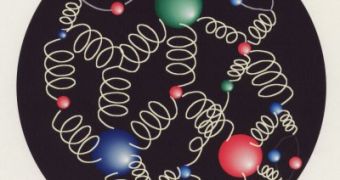A team of scientists working at an experiment called "Dzero" at the Department of Energy's Fermi National Accelerator Laboratory announced the discovery of a new heavy particle, called "zigh sub b" baryon, ?b.
This new particle, also known as "cascade b," has a mass six times greater than that of a proton, is electrically charged and is made of a down, a strange and a bottom quark. Quarks come in six flavors, and their names (up, down, strange, charm, bottom, and top) were also chosen arbitrarily based on the need to name something that could be easily remembered and used.
This new baryon is the first observed one, formed of quarks from three families of matter, and could provide scientists with new clues regarding the way the strong nuclear force acts upon the quarks, the basic building blocks of matter.
"Knowing the mass of the cascade b baryon gives scientists information they need in order to develop accurate models of how individual quarks are bound together into larger particles such as protons and neutrons," said physicist Robin Staffin, Associate Director for High Energy Physics for the Department of Energy's Office of Science.
It's called "cascade b" because it's produced in high-energy proton-antiproton collisions, and this type of baryon, made of heavy quarks, was abundant soon after the Big Bang at the beginning of the universe.
Being a short-lived particle, it can travel only a few millimeters after it's produced, before the action of the weak nuclear force causes it to disintegrate into two well-known particles. Before this experimental observation, only indirect evidence for the cascade b had been reported by experiments at the Large Electron-Positron collider at the CERN Laboratory near Geneva, Switzerland.
Because of the very short life of these particles, the odds of observing one of them are very reduced, and it took the team data from trillions of collisions produced over the last five years to identify these final decay products.

 14 DAY TRIAL //
14 DAY TRIAL //